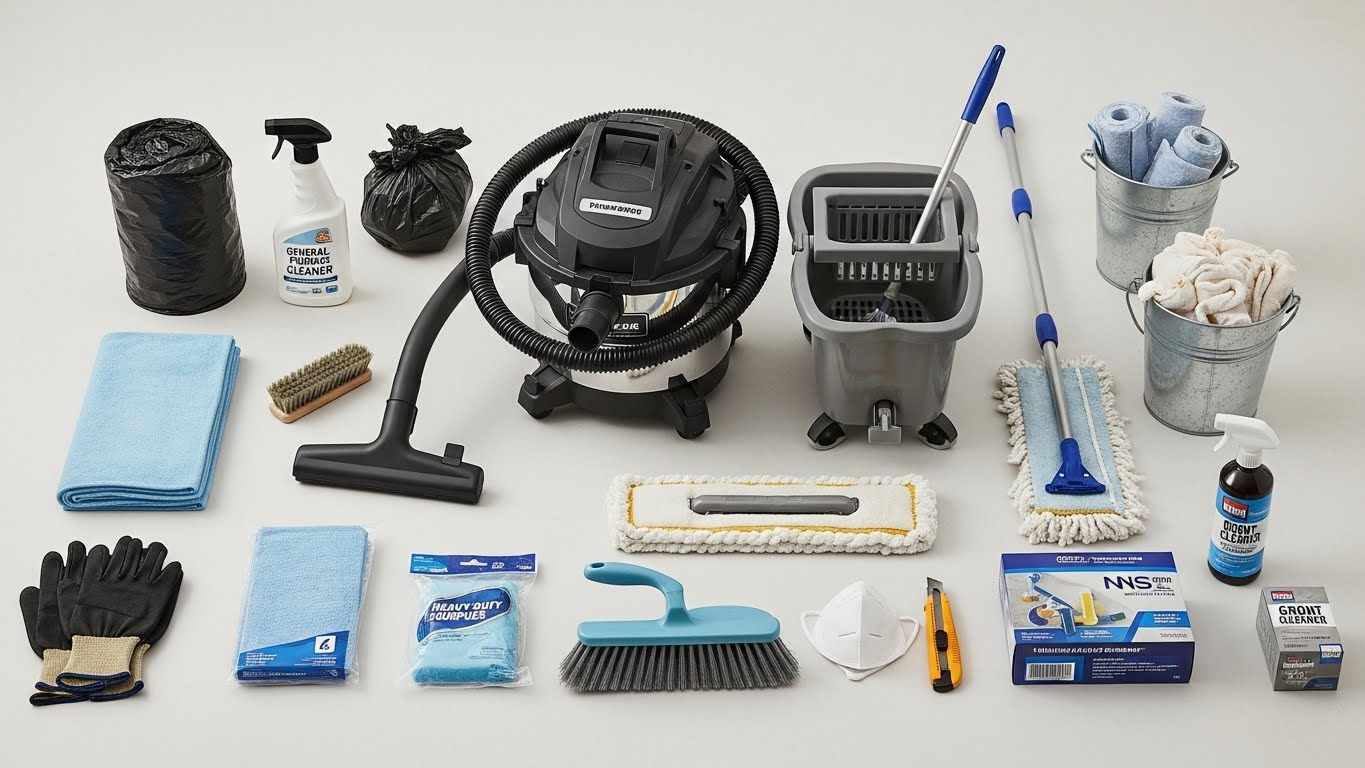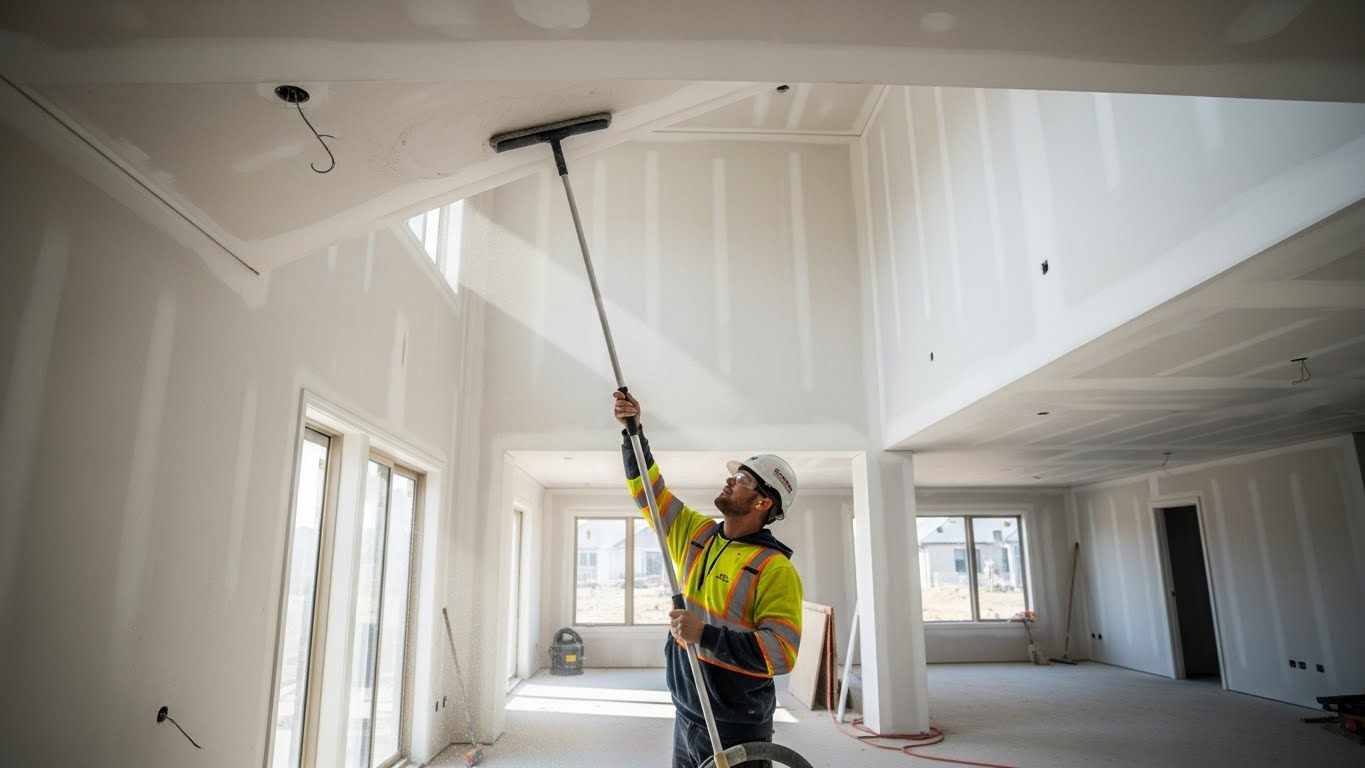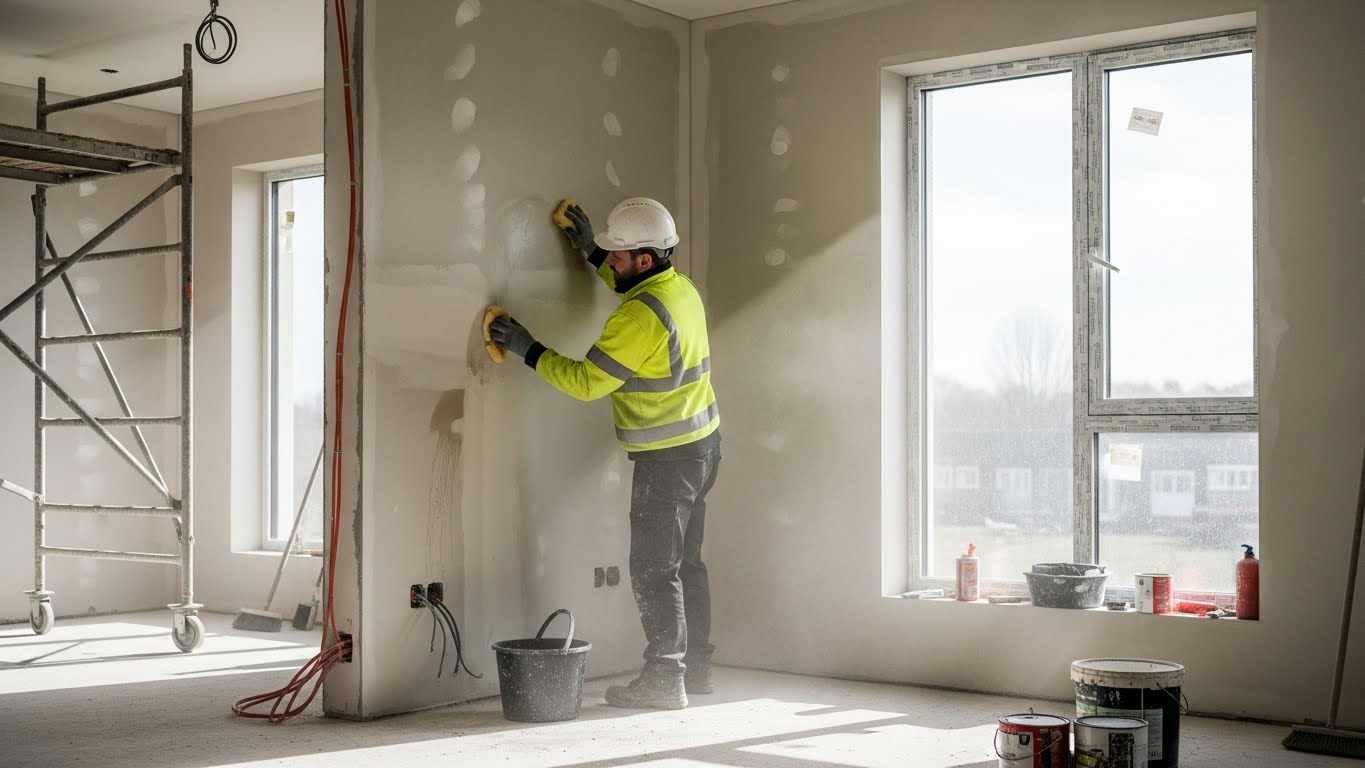When a home construction or renovation project ends, the building usually looks dusty, messy, and unfinished. Even when the builders do their part, fine plaster dust settles on every corner, walls may show fingerprints or smudges, and ceilings collect hidden layers of powder from sanding and drilling. Floors carry the heaviest load, with footprints, dried grout, tape marks, and leftover debris. Before a house becomes safe and comfortable for living, a thorough cleaning of these surfaces is needed.
Cleaning a newly built home is different from regular household cleaning. Fresh paint, new tiles, polished timber, and unsealed concrete are more sensitive and can easily be damaged. Construction dust contains fine particles, including plaster and silica, which spread through the air and return to surfaces if not handled correctly. For this reason, the cleaning process requires patience, clear steps, and the right tools. This guide explains how to clean floors, walls, and ceilings after home construction using safe and simple methods suitable for Australian homes.
Understanding Construction Dust and Why It Matters
Construction dust behaves differently from normal dust found in homes. It is lighter, finer, and more likely to spread through the air. Materials such as plasterboard, cement, timber, grout, and concrete create tiny particles during installation. According to SafeWork Australia, dust that contains silica can pose health risks if inhaled in large amounts, so proper dust control is an important part of post-construction cleaning.
Dust from a build often lands on high surfaces before drifting downward. This means ceilings and the upper parts of walls can hold far more dust than most people expect. When disturbed, this dust falls onto floors, skirting boards, and visible surfaces, making early cleaning steps crucial for a smooth and safe result.
Tools and Materials You Will Need

Cleaning a newly built home is easier and safer when using proper equipment. Most tasks can be completed with simple tools, as long as they are designed to handle fine dust and delicate surfaces. A HEPA-filter vacuum is one of the most important tools because it captures fine construction dust instead of blowing it back into the air. Microfibre cloths and mops help trap dust without scratching surfaces. Plastic scrapers are essential for removing dried plaster or paint without harming tiles or glass.
Long-handled dusters and extension poles help clean high ceilings and corners, allowing you to reach areas safely without overstretching. Mild detergents or neutral-pH cleaners protect delicate flooring materials like timber and vinyl. Soft brushes and non-abrasive sponges work well on walls, skirting boards, and tiles. Protective gear such as masks, gloves, and goggles adds safety when dealing with dust or chemicals.
Cleaning Ceilings After Home Construction

Cleaning ceilings is always the first step because dust naturally falls downwards during the process. Starting at the top prevents recontamination of walls and floors later.
Begin by dusting the entire ceiling using a long-handled microfiber duster. Move slowly across each section to avoid spreading dust throughout the room. Work in overlapping strokes to ensure that all areas, especially corners and edges, are thoroughly covered. Newly painted ceilings are delicate, so avoid pressing too hard.
Once the main dust is removed, inspect the ceiling for small marks. Light smudges or faint lines can often be cleaned with a slightly damp microfiber cloth, but always test the cloth on a small area first. Excess moisture may damage fresh paint or cause uneven patches. For ceilings with vents, fans, or downlights, turn off the power before wiping these areas. Dust around the fittings carefully to prevent particles from spreading into the air again.
Cleaning ceilings may seem subtle, but it significantly reduces the amount of dust that falls during later cleaning stages.
Cleaning Walls After Home Construction

Walls usually collect fingerprints, light smudges, dust trails, and small pieces of plaster. Begin by dry dusting the entire wall surface. Dry dusting with a microfiber cloth or dusting wand helps remove loose powder without smearing or creating streaks. Work from the top down so falling dust does not contaminate cleaned areas.
After dry dusting, move on to spot cleaning. A damp microfiber cloth with mild soapy water is usually safe for painted surfaces, especially those finished with modern low-VOC paints. Avoid harsh scrubbing because fresh paint can be soft and sensitive for weeks. Gentle circular motions are usually enough to remove marks.
If the walls contain dried plaster spots or small bumps, a plastic scraper can be used to remove them without damaging the paint. Never use metal scrapers, as they can leave scratches. For stubborn marks such as pencil lines, light use of a wall-safe cleaning pad may help, but always test it first.
Skirting boards should be cleaned last. They collect heavy dust and debris during building work, and cleaning them prevents dust from transferring to the floor when you begin mopping. A quick pass with a HEPA vacuum along the edges helps remove debris, followed by a damp cloth to finish.
Cleaning Floors After Home Construction

Floors are the most heavily affected surfaces in any construction project. They hold dust, footprints, packaging residue, and building scraps. The cleaning method depends on the type of flooring, so each material requires a different approach.
Tile Floors
Tiles are durable, but construction leaves behind materials such as grout residue, plaster dust, and dried adhesive. Start by vacuuming the entire area using a HEPA-filter vacuum to remove loose particles. This prevents scratching when mopping.
If there are dried paint spots or small plaster patches, use a plastic scraper to carefully lift them off. After spot cleaning, mop the floor with a neutral-pH solution to avoid damaging the grout or tile surface. Some tiles, especially matte tiles, may have a thin haze left from grouting. This haze can usually be removed with a soft cloth or a tile-safe cleaner.
Timber Floors
New timber floors are sensitive to water and scratches, so cleaning must be done with extra care. Begin with a soft-brush vacuum attachment to remove loose dust. Never use a hard-bristle broom, as it may scratch the surface.
Mopping timber floors should be done lightly. A damp microfiber mop is usually enough to remove dust and footprints. Avoid soaking the floor or using harsh chemicals because excess moisture can cause swelling or damage to the timber finish. Timber-safe cleaners are the safest choice.
Vinyl Floors
Vinyl flooring is common in new homes and can be cleaned effectively with soft tools. Vacuum or sweep gently to remove dust. Then use a damp mop with a vinyl-safe cleaner. Vinyl floors can be slippery when wet, so allow them to dry fully before walking on them.
Concrete Floors
Concrete floors, especially in garages or outdoor patios, collect fine dust from sanding and cutting. Begin by vacuuming thoroughly. Cement dust often contains silica, so HEPA filtration is important. After vacuuming, mop or scrub the floor with a neutral cleaner, then rinse with clean water. Allow the surface to dry completely.
General Safety Tips for Post-Construction Cleaning
Safety should be prioritised because construction sites contain hazards that normal homes do not. Wearing PPE such as gloves, masks, and goggles protects against dust and sharp debris. Opening windows during cleaning helps improve ventilation and reduces dust concentration. Ladders should be used carefully, with both feet stable and the ladder placed on a flat surface.
When cleaning newly installed surfaces, always test products in a small hidden area first. Some cleaners may be too strong for fresh paint or coatings. Avoid dragging tools or waste bags across the floor, as grit can scratch the surface. Keep the work environment organised to reduce the chance of slips or trips.
Common Problems and How to Prevent Them
One common issue is dust returning shortly after cleaning. This usually happens when ceilings and high areas are not cleaned first. Begin cleaning at the top of the room to prevent dust from falling onto already-cleaned surfaces. Another issue is streaks on walls or ceilings, which occur when wet wiping is done before dry dusting. Removing loose dust first helps prevent streaking.
Scratches on floors are often caused by debris being dragged across the surface or by using the wrong tools. Always vacuum thoroughly before mopping, and avoid metal blades on tiles or timber. Dried paint that does not come off easily can be softened with a safe cleaning solution, but scraping should always be done gently.
Hire Post-Construction Cleaning Professionals for the Best Results
Cleaning a newly finished home requires experience, the right tools, and an understanding of how construction dust behaves. Professional cleaners know how to work through each stage of the cleaning process without damaging new materials. They follow safe methods for removing plaster dust, adhesive marks, and residue.
Experts use modern equipment such as HEPA vacuums, extension poles, detailing brushes, and neutral cleaners. Their process ensures that every corner, high area, and flooring type is cleaned properly. Hiring professionals also removes the stress of managing the job yourself and reduces the risk of accidental damage. With trained cleaners, the property becomes safe, tidy, and ready for occupation much faster.
FAQS
What should I clean first—floors, walls, or ceilings?
Always start with the ceilings, then walls, and finish with the floors.
Why does construction dust keep coming back?
Fine dust falls from ceilings and high areas if not cleaned first.
Can I mop walls?
No, walls should be dry dusted first and then lightly wiped if needed.
How do I remove dried plaster from tiles?
Use a plastic scraper to avoid scratches.
Do I need a HEPA vacuum?
Yes, construction dust is too fine for standard vacuums.
Is it safe to use strong chemicals on new surfaces?
Only if they are surface-safe. Always test first.
How do I clean grout haze?
Use a soft cloth or tile-safe grout remover.
Can I use metal scrapers on floors or walls?
No, metal tools can scratch surfaces.
How long does it take to clean after construction?
It depends on the level of dust and the size of the home.
Should I hire professionals?
Yes, especially if the dust level is high or the home contains delicate materials
